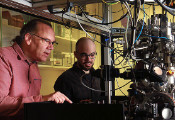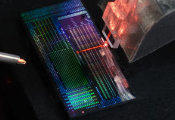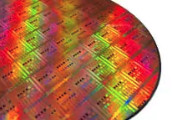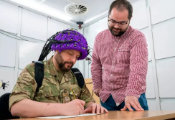PPPL Unveils New Laboratory Space To Advance Quantum Information Science
March 12, 2024 -- Building on its more than 70 years pioneering the study of fusion energy, the U.S. Department of Energy’s (DOE) Princeton Plasma Physics Laboratory (PPPL) has added a new field to its research portfolio — quantum information science.
On March 11, PPPL opened its new Quantum Diamond Lab (QDL), a space devoted to studying and refining the processes involved in using plasma, the electrically charged fourth state of matter, to create high-quality diamond material for quantum information science applications. Scientists around the world are exploring quantum diamond as a way to harness the properties of atoms and particles for a variety of tasks, including performing calculations far faster than today’s computers can, enabling secure communications and measuring temperature and magnetic fields with unparalleled precision.
“With the opening of the Quantum Diamond Laboratory, PPPL moves into the next generation of information technology: quantum materials and devices,” said Emily Carter, PPPL’s senior strategic advisor and associate laboratory director for applied materials and sustainability sciences(Link opens in new window), as well as the Gerhard R. Andlinger Professor in Energy and the Environment, professor of mechanical and aerospace engineering, the Andlinger Center for Energy and the Environment, and applied and computational mathematics at Princeton University. “The Lab is becoming a leading research facility for the growth of quantum materials. We are using our expertise in plasma to serve as a technological driver of economic innovation — improving the plasma processes used to make computer chips, advancing quantum sensors and communication(Link is external) and contributing to a net-zero world. By doing so, we aim to strengthen the U.S. contributions to industries critical to our nation’s future.”
The Quantum Diamond Lab contains machines that use plasma to create diamond material infused with other elements that allow scientists to create a structure known as a quantum bit, or qubit. Qubits could enable a range of jaw-dropping applications, including breaking unbreakable codes, measuring the temperature of microscopic structures inside cells and helping diagnose cancer.
“We are bringing two significant innovations to the quantum world,” said Alastair Stacey, managing principal research physicist at PPPL and one of the world’s leading quantum diamond experts who was recruited to lead the Quantum Diamond Lab. “The first is the introduction of co-doping, with simultaneous control of both electronic and quantum aspects. The second is the application of PPPL’s deep plasma expertise to measure the plasma in great detail and create accurate simulations of the plasma and diamond growth process. By combining these elements, we expect to be able to significantly advance the use of existing plasma tools, as well as make new quantum materials and invent new plasma tools.”
For Stacey, PPPL is the ideal place to set up camp. “Because of its decades of experience with fusion, PPPL is the global epicenter for hydrogen plasmas,” he said. “And since the quantum information science that involves diamond requires hydrogen expertise, PPPL is an ideal site for my research.”
“Launching this new quantum diamond effort at PPPL is very exciting,” said Nathalie de Leon(Link is external), associate professor of electrical and computer engineering at Princeton University. “Alastair and I have been working on developing ideas for making better quantum sensors ever since we began collaborating when I was a postdoc. Having a space where we can actually test some of these more adventurous ideas is thrilling.”
The peculiar world of the very small
Quantum information science relies on the counterintuitive properties of tiny objects like atoms and the even smaller electrons that buzz within them, captured in a set of mathematical descriptions known as quantum mechanics(Link is external).
Research by physicists, including Paul Dirac and Werner Heisenberg about a hundred years ago, established that these minuscule motes of matter behave in ways unfamiliar to human beings. For instance, their findings showed that one cannot calculate for sure where an electron is as it orbits an atomic nucleus. Rather, scientists can only figure out the probability that an electron might be found at a particular location. Until researchers check with a microscope or another tool, the electron exists only as a nebulous idea, a cloud of chance. In fact, until the measurement has occurred, the electron can be said to exist in more than one location at the same time, a phenomenon known as superposition.
Scientists hope to use this strange quality to enable a range of innovations, including future generations of computers. Current computers store information in the form of bits, systems that can exist in one of two states. In standard, classical computer chips made of silicon, bits can have values of either 1 or 0. But theoretically, a bit doesn’t have to consist of microscopic silicon at all. “In fact, a door could be a bit,” said Stacey, “since its hinge allows it to be either open or closed.” Stacey and his colleagues want to help electrons enter a superposition state to make a new type of bit known as a quantum bit, or qubit. “The advantage of qubits is that while they are in their superpositions, they can hold much more information than regular bits can,” Stacey said. “This means that they can also give us much more information about their environment, making them extremely valuable as sensors.”
Capturing and using quantum effects
One way to create qubits involves diamond, a material made of the same carbon atoms that form the graphite in your pencil that are configured in a frame-like structure known as a lattice. By removing one carbon atom from the lattice and replacing it with a nitrogen atom, and then removing a neighboring carbon atom and leaving the space empty, scientists can create a particular arrangement of electrons that form a qubit known as a nitrogen-vacancy (NV) defect. In fact, only one NV defect out of a hundred million billion other carbon atoms can make quantum science possible.
Diamond also helps preserve the qubits because the qubits in the lattice do not easily interact with other atoms or electrons. “For this reason, the lattice behaves like a vacuum, meaning that scientists like me can use the qubits in research,” Stacey said.
To build such small structures, scientists rely on a process akin to 3D manufacturing known as chemical vapor deposition, in which complicated machines lay down sheets of carbon atoms atop each other to form the lattice. The challenge is preventing the carbon from forming graphite; researchers want diamond instead. Doing so requires hydrogen, which, in turn, relies on using plasma.
The plasma absorbs electricity beamed into it from outside and then transfers that electrical current to surrounding hydrogen gas, heating it up. Once the gas gets hot enough, the hydrogen molecules split into individual hydrogen atoms that then bind to the surface of the carbon lattice, ensuring that it remains diamond. “Without these specialized plasma systems, it’s not easy to heat the gas to the required temperatures while maintaining chemical purity, which is critical for quantum applications,” Stacey said.
The opening of the Quantum Diamond Lab marks the completion of a challenging, years-long Laboratory effort. “We spent more than two years planning, designing and constructing a new laboratory in the midst of one of PPPL’s original buildings with minimal disruption to ongoing experiments,” said Eric Bourgie, PPPL facilities project manager in charge of the QDL. “Now, the project team is very proud to hand over the space to the research team so that the next phase of the laboratory’s life can begin.” In coming months and years, additional steps will bring further capabilities to the Lab to enhance its research program.
The QDL is supported by the DOE’s Office of Science (Fusion Energy Sciences and Basic Energy Sciences). Princeton University contributed funds to support the basic infrastructure and footprint of the QDL, making it compatible for long-term growth.
PPPL is mastering the art of using plasma — the fourth state of matter — to solve some of the world’s toughest science and technology challenges. Nestled on Princeton University’s Forrestal Campus in Plainsboro, New Jersey, our research ignites innovation in a range of applications including fusion energy, nanoscale fabrication, quantum materials and devices, and sustainability science. The University manages the Laboratory for the U.S. Department of Energy’s Office of Science, which is the nation’s single largest supporter of basic research in the physical sciences.




































